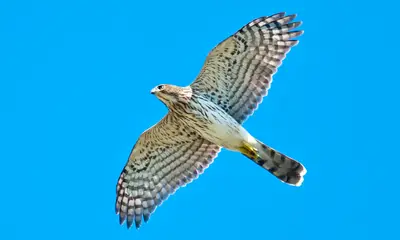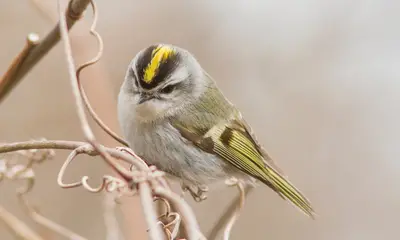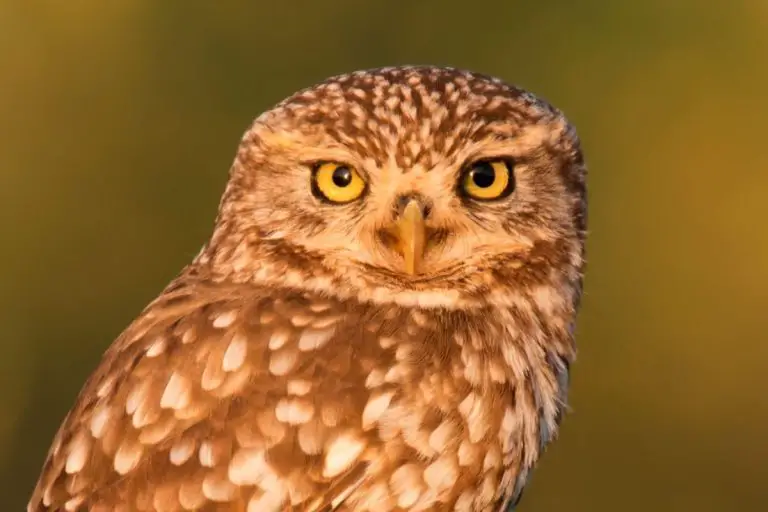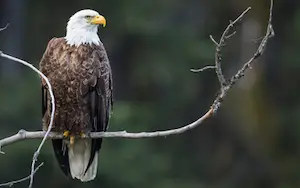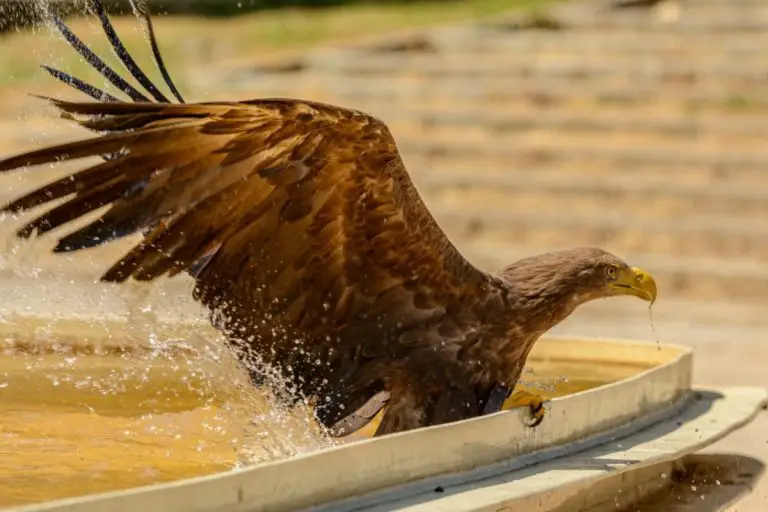21 Types Of BLACK Birds In Texas (ID Guide With Photos)
Did you recently come across a black bird in Texas, and want to know what species it was?
Identifying the black-colored birds of Texas is not as easy as it might seem, since there are many bird species in the Lone Star state that are either completely black or partially black.
To help you identify the bird you saw, we’ll cover all the different black-colored birds found in Texas.
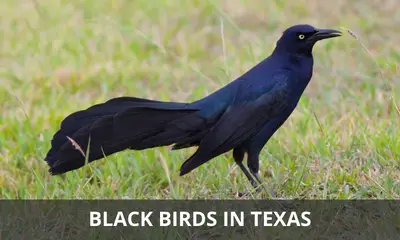
What types of black birds are found in Texas?
The 21 types of black-colored birds found in Texas are:
- Great-tailed Grackle
- Common Grackle
- Boat-tailed Grackle
- Red-winged Blackbird
- Rusty Blackbird
- Brewer’s Blackbird
- Yellow-headed Blackbird
- Bobolink
- Common Starling
- Brown-headed Cowbird
- Bronzed Cowbird
- Orchard Oriole
- Scott’s Oriole
- Baltimore Oriole
- American Crow
- Common Raven
- Anhinga
- Common Gallinule
- American Coot
While many of these birds are year round residents of Texas, others only occur in the state during the nesting season in summer.
Yet other species are found in Texas during the winter, and some are vagrants that only rarely occur in the state.
Now let’s dive into the details, and take a closer look at each of these black-colored bird species in order to get the full scoop:
Great-tailed Grackle
Scientific name: Quiscalus mexicanus
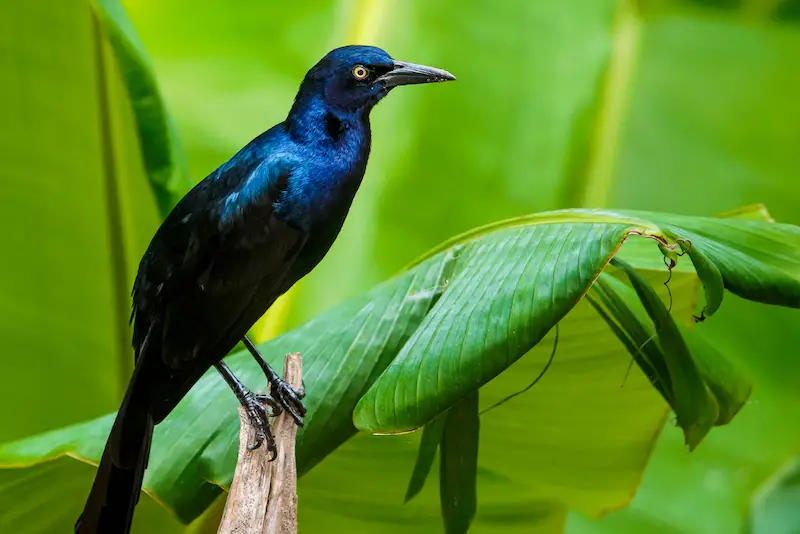
The Great-tailed Grackle is a blackbird species in Texas that breeds across the southern states of the USA, with its northernmost range extending to the southern Midwest.
It is the most common blackbird found in Texas, and its numbers have steadily increased over the last decades.
Adult males have yellow eyes that stand out against their iridescent black bodies. Juveniles and adult females are brown on top and lighter brown on the bottom.
One of the best distinguishing features of these large black-colored birds is their extra long, wedge-shaped tail.
The central part of its tail hangs down, which creates a V-shaped cross section that is highly characteristic for these blackbirds.
Females of this blackbird species have a shorter tail and a smaller body than males, and almost look like a distinct species.
Great-tailed Grackles frequently gather in loud roosts in trees and on telephone wires.
They compete over garbage in urban areas, and peck for food with other blackbird species on fields, golf courses, and lawns.
In the breeding range of this blackbird, roosting and breeding locations are provided by large trees that border swampland, lagoons, and marshes.
Outside of the breeding season, Great-tailed Grackles forage on open fields and can be found in cultivated areas, as well as urban settings, such as large lawns, and even parking lots.
Common Grackle
Scientific name: Quiscalus quiscula
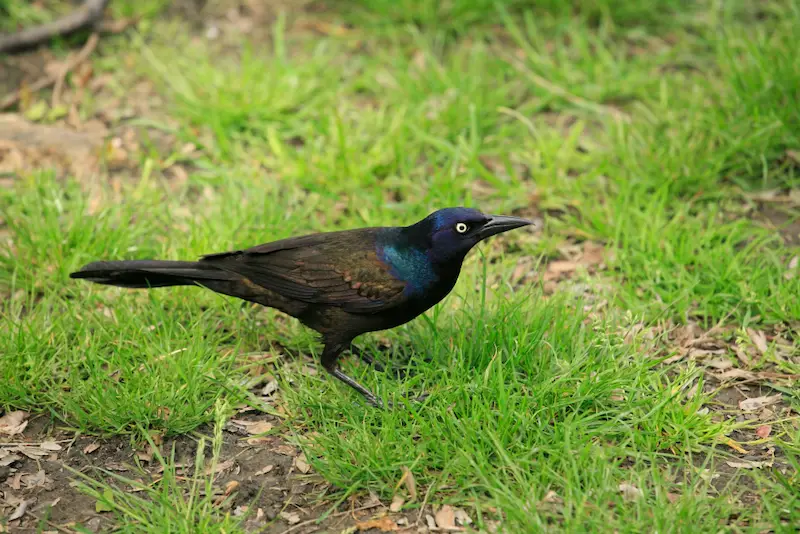
The Common Grackle is the smallest of the three grackle species in Texas.
From a distance it looks like an entirely black-colored bird, making it easy to confuse it with a crow, which is also entirely black.
But in contrast to a crow, the Common Grackle has a pointed beak that is formed like a cone, as well as eyes that are bright yellow, and a long tail that is shaped like a wedge.
In Texas, it is mostly found in east and north Texas, and lives in open spaces such as meadows, parks, and fields, as well as suburban and residential regions.
Male Common Grackles have shimmering purple coloration on the black feathers of their heads, breasts, and necks, as well as other parts of their bodies.
During the nesting season, the females construct large nests in which they will lay a clutch of about five eggs.
In northern parts of its range, the Common Grackle is a migratory summer visitor, but in Texas it can be found year round.
It is a member of the family of New World blackbirds, which contains some of the most common birds in Texas, many of which like to gather in huge flocks and make a lot of noise.
On farms, Common Grackles can congregate in large numbers to feed on crops and grain, and to roost, which can cause a problem to Texas farmers.
Because it is such a versatile species, this blackbird can thrive in many different environments.
Boat-tailed Grackle
Scientific name: Quiscalus major
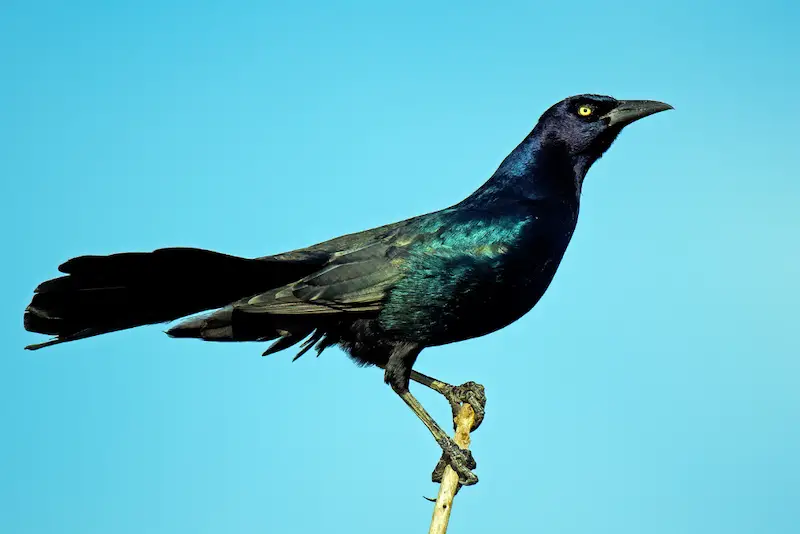
Bigger than the Common Grackle, the Boat-tailed Grackle is best identified by its long tail that has a broad end resembling a spatula.
Similar to other grackles, the tail is often folded in the shape of a keel, with the tail margins held higher than the center.
Adult male Boat-tailed Grackles are entirely glossy black with a metallic sheen that’s strongest on the head and back.
This blackbird is a year-round resident in Texas, and is most often found in marshy habitats, as well as urban parks.
Rusty Blackbird
Scientific name: Euphagus carolinus
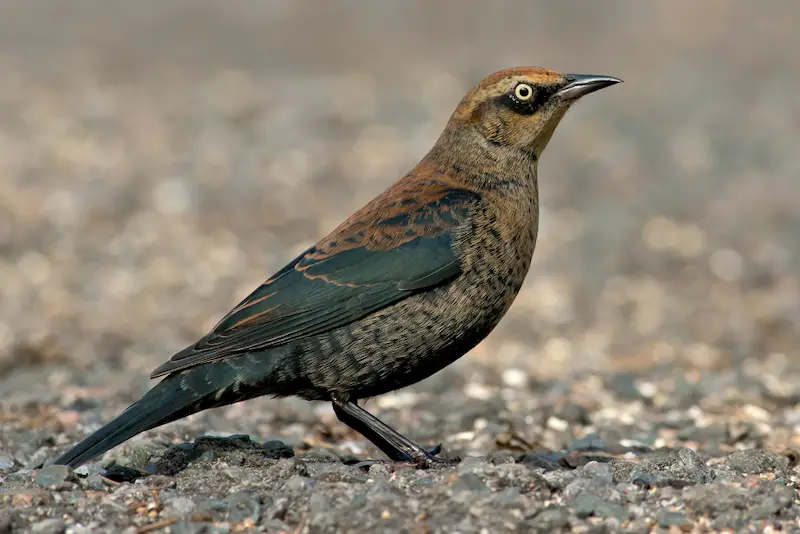
The Rusty Blackbird is substantially less of a problem to agricultural activities than some of the other members of its family.
The reason for this is that it breeds in regions that are remote and are located in marshy, non-cultivated areas.
Adult male Rusty Blackbirds are uniformly black, while females and juveniles are brownish gray with some black feathers.
During the autumn months, the plumage of the male transforms into a drab, rusty brown color.
During the fall migration it is easiest to spot this bird in Texas, since it travels south from its main breeding grounds in Canada, and passes through Texas in large flocks at this time.
While large numbers pass through Texas on their fall and spring migrations, some spend the whole winter, and can be seen in Texas from September through late April.
Their preferred habitat is swampland, marshy areas, and the banks of lakes and rivers.
Unfortunately, there has been a dramatic decline in the population of this species, and it is now on the red list of the IUCN.
Red-winged Blackbird
Scientific name: Agelaius phoeniceus

The Red-winged Blackbird is one of the more common birds in Texas. The great thing about these black and red Texas birds is that you can easily distinguish males from females.
Male Red-winged Blackbirds are mostly black except for the bright red patches on their wings. In contrast, females (and juveniles) are blackish brown with white streaks.
The Red-winged Blackbird lives in open fields near water. It is most often found in marshes, wetlands, and around lakes.
To find food, the Red-winged Blackbird travels many miles a day, especially outside of the nesting season.
While it is primarily a seed-eater during fall and spring, it switches to feeding almost exclusively on insects during summer.
Depending on where it is found, the Red-winged Blackbird is either a seasonal migrant (in the north of its range), or a resident (in the south of its range).
Red-winged Blackbirds roost in flocks up to millions of birds strong, creating a deafening noise with their rapidly beating wings.
In spring, male Red-winged Blackbirds are usually the first ones to arrive in order to claim a desirable territory before the females arrive.
During the mating season, the male red-winged blackbird will sing from a conspicuous perch and display the red shoulder patches on his feathers in order to attract the attention of females.
After a female chooses a mate, she builds her nest over shallow water in a thick stand of vegetation. Her chosen mate then aggressively defends the nest against other blackbirds.
The most successful males are bigamous, and can mate with multiple females at the same time.
Brewer’s Blackbird
Scientific name: Euphagus cyanocephalus
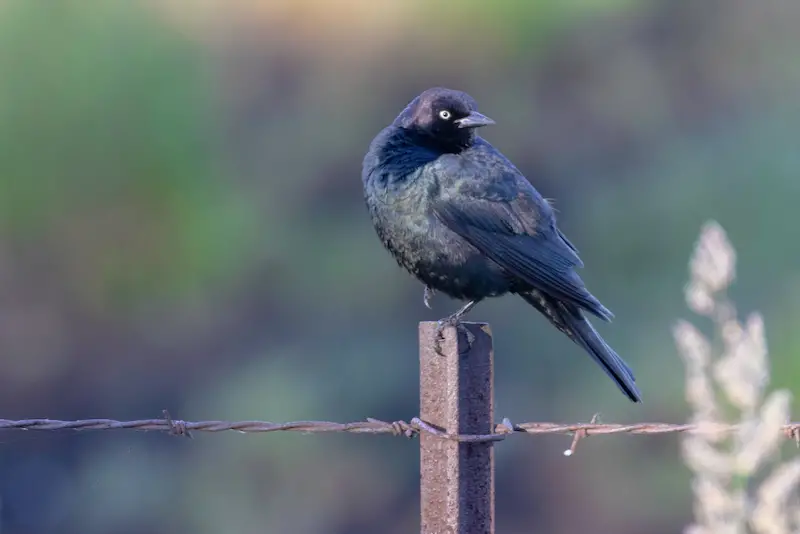
In a large portion of its range, the Brewer’s Blackbird appears to choose environments that have been shaped by humans, rather than natural ones.
However, in areas where it competes with the Common Grackle, it instead prefers more rural areas. These blackbirds make sounds that are usually described as shrill and metallic.
Similar to other species in its family, Brewer’s Blackbirds like to congregate in large flocks in autumn, and feed on leftover seeds and grains found on farmland after the harvest.
It is about the size of a robin and has long legs and a long black tail. When they are seated on the ground or perched on a branch, their tails give the appearance of being broadened and rounded.
Adult males are completely black with a purple sheen on the black feathers of their head, which fades into a greenish hue on the rest of their body.
In contrast, females and juveniles are a more uniform brown color, with their wings and tails being grayish black.
You can find it in open habitats, such as coastal marshes, grasslands and meadows, but also agricultural and urban areas, such as parks and lawns.
Of all the types of blackbirds in Texas, the Brewer’s Blackbird is relatively rare, and is mostly observed as a scarce migrant during spring and fall.
Yellow-headed Blackbird
Scientific name: Xanthocephalus xanthocephalus
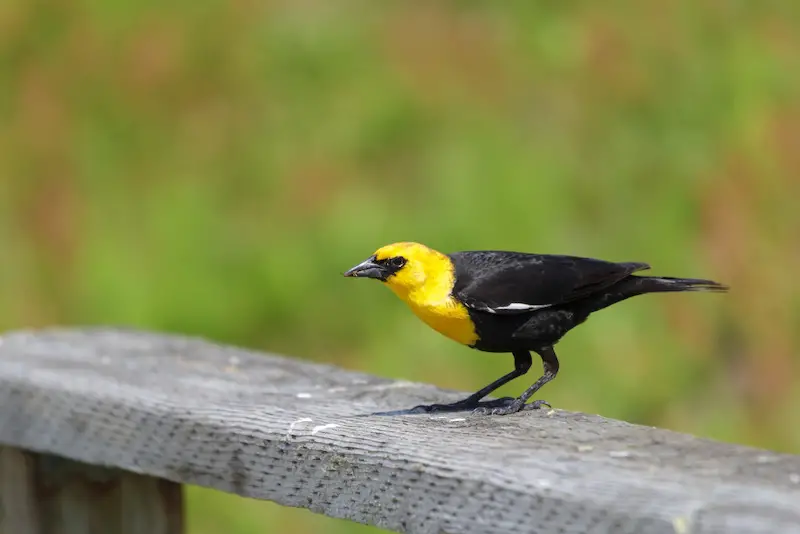
Yellow-headed Blackbirds are breeding birds in the northernmost tip of Texas, but also occur throughout the rest of the state during migration.
Adult male Yellow-headed Blackbirds stand out thanks to their distinctive yellow heads and chests, paired with a jet black body.
Females and immatures of this blackbird have drab yellow heads and are dark brown rather than black.
Male Yellow-headed Blackbirds will often mate with a number of different females during the breeding season, forming small colonies of nests.
Outside of the breeding season, Yellow-headed Blackbirds gather into massive flocks, frequently mingling with other species of blackbirds, and feed on leftover grains on farmland.
At this time it is common for it to forage in fields and spend their winters in open cultivated areas.
During the summer months, they feed mostly on insects and other small invertebrates. In Texas, this blackbird is most often observed during spring and fall migration.
Typically, Yellow-headed Blackbirds breed in lowland areas with wetlands and dense growth of cattails.
Bobolink
Scientific name: Dolichonyx oryzivorus
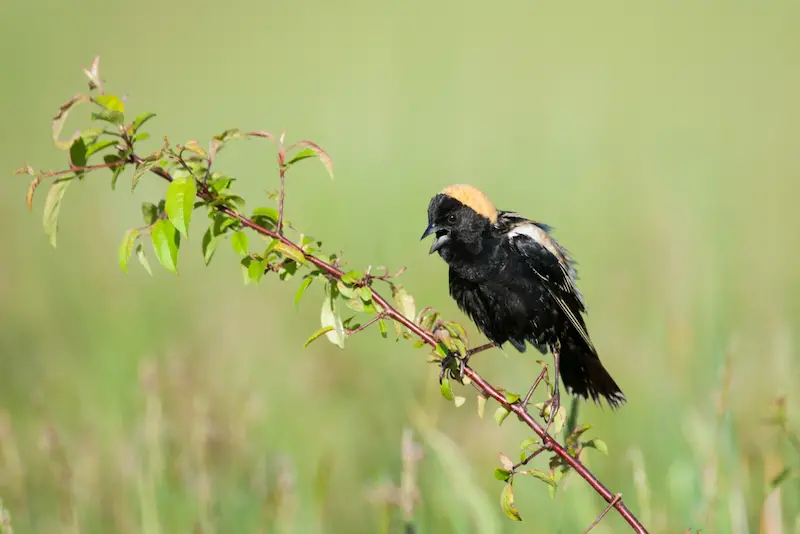
The Bobolink is another species of blackbird in Texas.
It is an increasingly rare blackbird that breeds in southern Canada and the northern United States. Its preferred habitat are large fallow fields.
Adult male Bobolinks are mostly black, but have a cream colored cap, as well as patches of white on their wings and back.
Females and juveniles of this blackbird species are much more inconspicuous. They are brown on top, and pale yellow on the bottom, and they also don’t have a white wing patch.
In the spring, the males engage in a conspicuous territorial display known as “helicoptering,” during which they hover in the air and sing voluminously to attract females and establish their territory.
Unfortunately, Bobolink numbers have decreased not just in places where they breed but also in locations where they spend the winter.
This decline is caused by habitat degradation and farming practices that involve haying when these blackbirds are still nesting.
These migratory blackbirds spend the cold season in Central America, and can be spotted in Texas during fall and spring, when they pass through the state on their migration.
Common Starling
Scientific name: Sturnus vulgaris
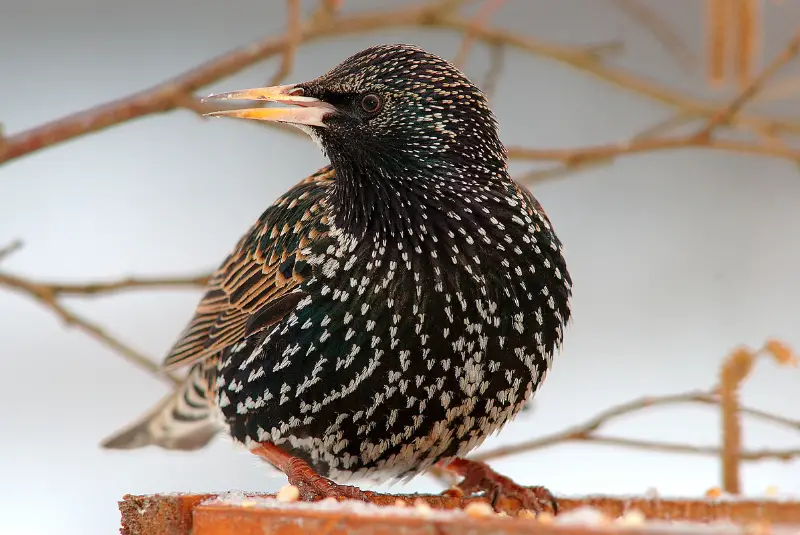
The Common Starling (also known as European Starling) is a common and highly successful bird in Texas. Adult Common Starlings are uniformly black with a glossy sheen.
During winter, Common Starlings are black, but covered with light spots, which can be a great characteristic to identify them.
This black species is originally from Europe, Asia, and North Africa, but it was introduced to North America and many other parts of the world, where it has established itself as a successful breeding species within a short period of time.
Common Starlings inhabit open country with few trees as their original habitat, but they are also among the most successful urban species, and are especially common in parks and gardens.
While Common Starlings nest in tree holes in the wild, they are also known to nest inside buildings and nest boxes in urban settings.
Unfortunately, native birds are sometimes driven out of their nesting sites by competing Starlings.
Similar to grackles and other blackbirds, Common Starlings form large flocks outside of the nesting season.
These flocks can contain more than a million individuals, and can be seen performing amazing aerial acrobatics.
Brown-headed Cowbird
Scientific name: Molothrus ater
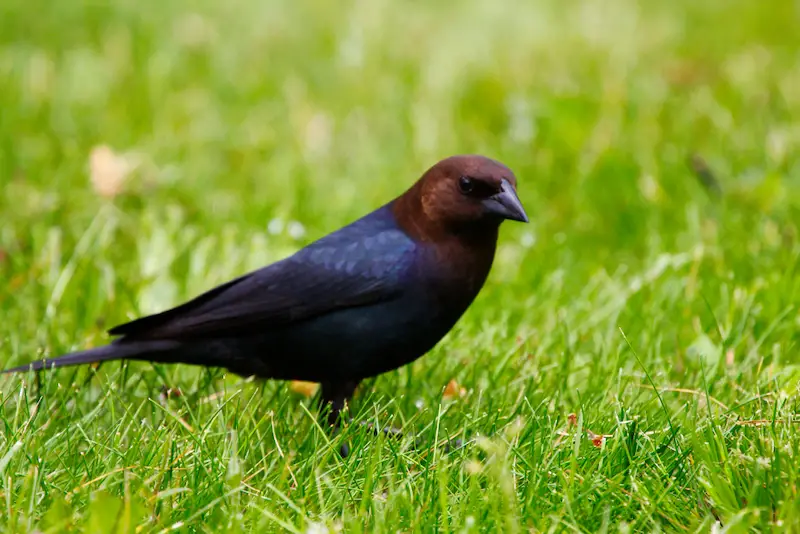
Cowbirds also belong to the blackbird family, but differ in one key characteristic: they are brood parasites.
A brood parasite is a type of bird that doesn’t build nests, but instead lays its eggs in the nests of other birds.
Brown-headed Cowbirds have been reported to lay their eggs in the nests of hundreds of other bird species.
Only a few of the host birds targeted by Cowbirds can identify the parasitic eggs as alien, and will abandon them.
Most hosts incubate the Cowbird eggs and raise the resulting nestlings as if they were their own.
If you see a warbler or other small bird in Texas feeding a young bird twice its size, you can be sure that it’s raising a Cowbird.
Adult male Brown-headed Cowbirds have a chocolate-brown head and an iridescent black body, as well as a black eye. Females, on the other hand, are dull gray-brown with shades of black.
Cowbirds got their name because they like to follow buffaloes and cattle around in order to eat a wide variety of insects and other small animals that are disturbed by the large animals.
It can be seen in Texas year-round, though it tends to move around a lot in the non-breeding season searching for food.
Brown-headed Cowbirds typically forage for food on the ground in flocks that also contain other types of blackbirds and starlings.
Bronzed Cowbird
Scientific name: Molothrus aeneus
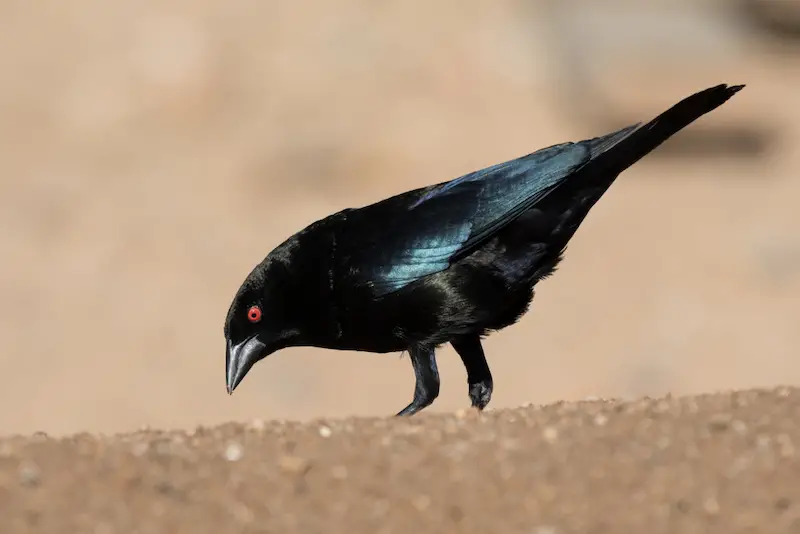
The Bronzed Cowbird is a sturdy blackbird that has a curved, pointed beak. Its name comes from the bronzed sheen on the black plumage of the males.
Similar to Brown-headed Cowbirds, Bronzed Cowbirds are also brood parasites that don’t build their own nest, but instead lay their eggs into the nests of other birds.
The feathers on the male’s nape are fluffed up during mating displays, which contributes to the thick appearance of the male’s neck.
Males also perform a “helicoptering” flight display in order to attract females.
Adult males of this blackbird are uniformly black with a bronze shimmer, and have red eyes. The females in Texas are gray brown.
These blackbirds like to forage for food in large groups, primarily on the ground, where they look for insects and seeds.
You can find Bronzed Cowbirds in open areas, such as farmland and prairie, and more urban areas, such as golf courses.
Orchard Oriole
Scientific name: Icterus spurius
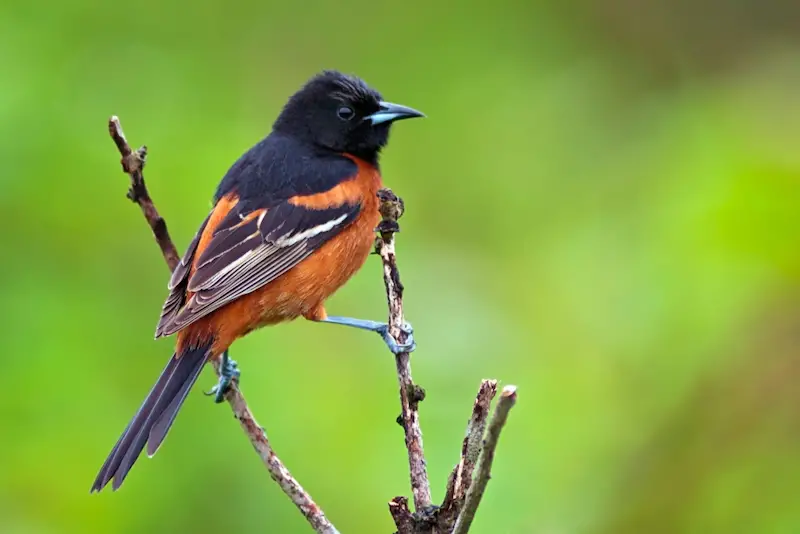
This Oriole got its name from its preference for orchards and open woods. It is a summer visitor in Texas, and is most commonly found in south Texas brush country.
Unlike the females (which are mostly dull yellow with black wing tips), males are a dark orange color with a black head, as well as a black throat, upper back, wings, and tail.
Young males resemble females in color, and gradually become more and more black over their first two years.
Early in the summer, the Orchard Oriole feeds on insects, but later it will switch to eating wild fruit as they become mature.
After their young have fledged, parent Orioles will bring them to feeding stations (especially if you have a nectar feeder.
Some people mistakenly believe that the orioles have departed since they do not see them at their feeders very often during the peak of the summer.
However, the orioles are still present nearby, but are simply focused on catching insects to bring back to their nestlings.
The Orchard Oriole is one of the birds that gets here very late in the spring and is one of the ones that leaves quite early in the fall.
Scott’s Oriole
Scientific name: Icterus parisorum
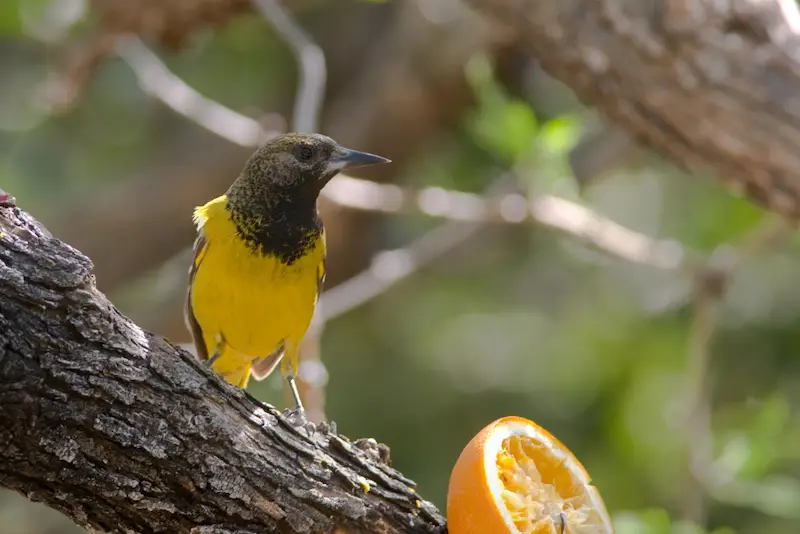
Scott’s Oriole is commonly found in the Southwestern part of the United States, and is a common breeding bird in west Texas.
Scott’s Oriole is a medium-sized bird that is highly conspicuous due to its flaming yellow underside.
However, only the lower part of this oriole is yellow in color. Its head, back, breast, tail, and wing are a stunning jet black color.
A type of iceterid, it is most famously known as the desert or mountain oriole, as it prefers to live in high desert regions or along mountain slopes in Mexico and Central America, as well as the southern United States.
It frequents both dense oak forests as well as more open landscapes with scattered trees and yucca plants.
The favorite food of this oriole is yucca nectar, and as a result of this, they are on occasion observed at bird feeders offering nectar (or sugar water) in southeastern Texas and along the Gulf Coast.
Baltimore Oriole
Scientific name: Icterus galbula
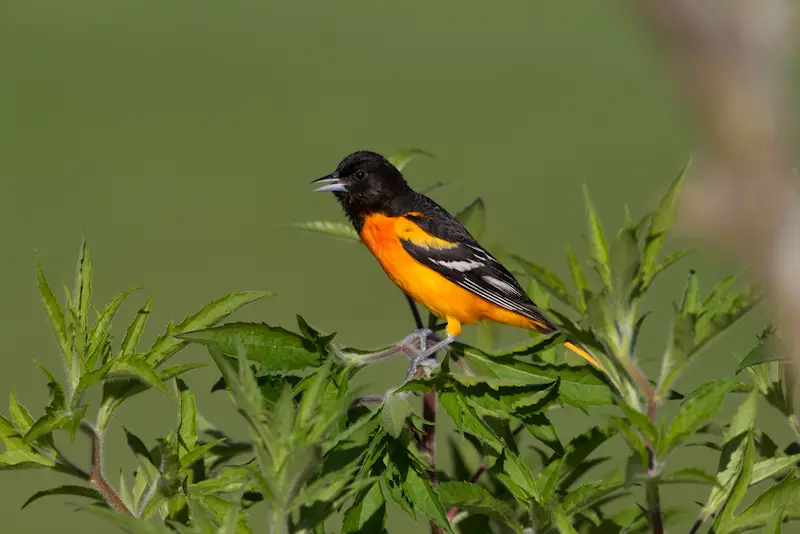
The Baltimore Oriole is a wonderful singer that is more frequently heard than seen.
Adult males have a conspicuous combination of flaming orange and black with white wing bars.
Females and immatures are much more drab, and have a brownish yellow coloration. Females also lack the black coloration.
Baltimore Orioles are readily attracted to feeders that contain orange halves, grape jelly, or nectar.
And similar to Orchard Orioles, parents bring their recently fledged young to a nearby feeder.
It favors open spaces such as yards, parks, and woods, and frequently comes back to the same location year after year.
Keep an eye out for Baltimore Orioles in deciduous forests, but not in dense woods. You may encounter them in places like open forests, forest margins, orchards and even backyards.
Due to the fact that they forage high in trees in search of insects, fruit, and flowers, most orioles in Texas are more frequently heard than seen.
The Baltimore Oriole is a rare species in Texas, and is one of the latest migratory birds to arrive in spring, and one of the earliest to leave in fall.
American Crow
Scientific name: Corvus brachyrhynchos
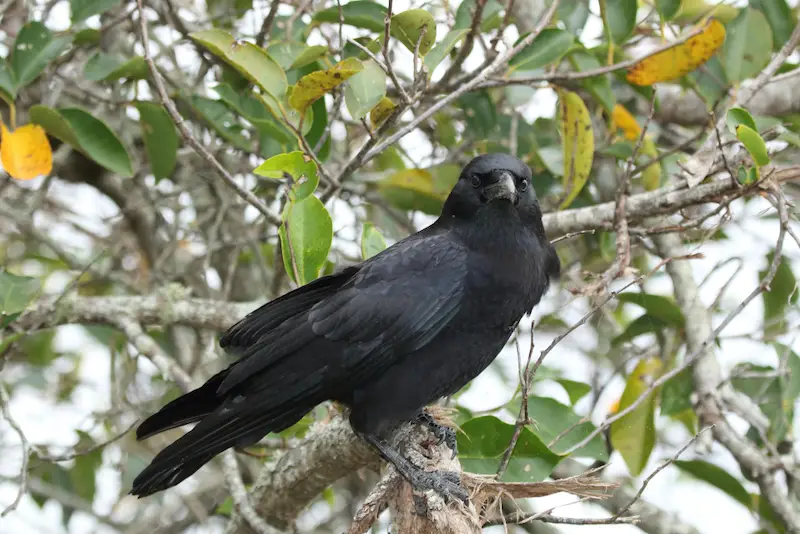
This is one of the most easily recognized black-colored birds in Texas.
American Crows are entirely black, including black beaks, legs, and eyes. Both adults and immatures are completely black, and hard to distinguish from each other.
This is one of the most intelligent birds in the world. It also happens to be one of the most sociable, and it likes to pass the time by harassing other birds.
Similar to vultures and other birds of prey in Texas, American Crows like to feed on roadkill, but rarely get hit by cars themselves.
The American Crow builds a big stick nest in trees, which it likes to reuse for many years. Old crows nests are also used by many other species, including raptors and owls.
Family groups of crows sleep together at night but split off during the day to go foraging.
Outside of the breeding season, it forms massive flocks, sometimes topping out at thousands of birds.
American Crows are common in Texas in open woodlands and forests, as well as farmland and urban areas such as parks, golf courses, and large gardens.
Common Raven
Scientific name: Corvus corax

The Common Raven is a large Texas bird, with a wingspan of up to 4.9 feet. In fact, it’s the largest songbird in North America.
These large black birds mate for life, and an established pair will defend its territory all year round.
As a result of this behavior, they are very rarely observed in flocks, which distinguishes them from other corvids.
The Common Raven is primarily found in the mountainous regions of Texas in the Trans Pecos. Their preferred habitat is oak forest and mesquite shrubland.
Anhinga
Scientific name: Anhinga anhinga
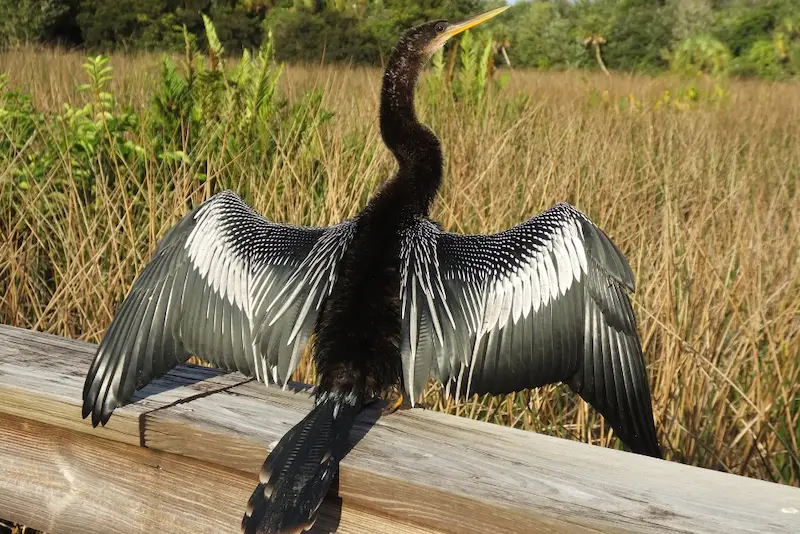
The Anhinga looks similar to a cormorant, but has a snake-like neck, which it uses to catch fish underwater.
When it is in the water, it’s common to see only the head and neck protruding above the water surface.
Adult male Anhingas are almost entirely black, while females have a dark brown head and neck, as well as black body plumage.
It lives in swamps and freshwater ponds, and is a year-round resident in Texas.
Common Gallinule
Scientific name: Gallinula galeata
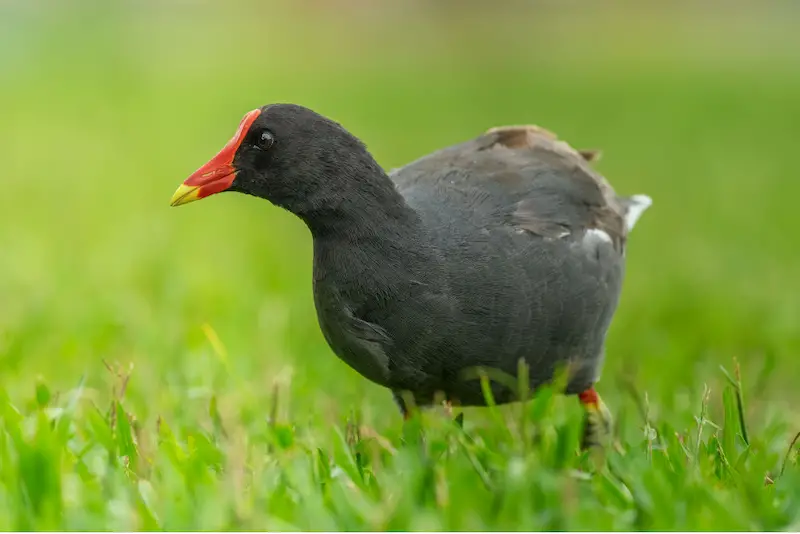
The Common Gallinule is a type of marsh bird that is medium in size and has long green legs and toes.
Both the male and female have a charcoal black body with a white stripe running down the side, and their outer tail feathers are also white.
Common Gallinules can swim in the water like ducks or geese, and are also able to walk on top of floating plants. They have a habit of walking in a crouching position and regularly twitching their tail up.
Common Gallinules usually remain in close proximity to the protection offered by marsh plants, although they sometimes swim in open water.
Their favored habitat is found in ponds, marshes, and lakes that have sufficient aquatic plants mixed in with open water. When foraging, they will also undertake excursions to canals and ditches.
In Texas, the Common Gallinule is a relatively scarce summer visitor breeding in marshes and lakes.
American Coot
Scientific name: Fulica americana
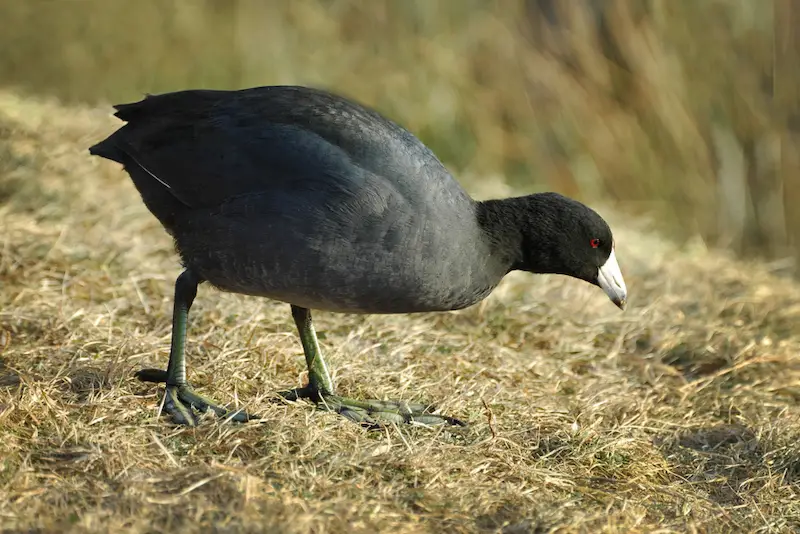
American Coots are regularly observed congregating in huge flocks on open water (especially during migration).
Coots range in color from dark gray to black and have a white beak and forehead, as well as a red eye.
While American Coots are water birds, they don’t have webbed feet like ducks, but instead have broad, lobed toes.
In addition to their ability to swim on top of the water, Coots are also strong divers, and often forage for food on the bottom of shallow lakes and ponds.
Bald Eagles like to prey on Coots, and will try to tire out an individual by repeatedly forcing it to dive until it is too exhausted and gives up
American Coots may be found in a variety of aquatic habitats, including urban park ponds, reservoirs, marshes, and lake shores.
Its nest is a floating platform that is anchored to the surrounding plants.
The American Coot is a relatively scarce breeding bird in Texas, but during winter its numbers swell due to an influx of wintering individuals that arrive from northern states.
What are the most common black birds found in Texas?
The most common black birds in the Lone Star state are Great-tailed Grackles. They are regular breeding birds all over Texas, and frequent guests at bird feeders offering black oil sunflower seeds.
Outside of the breeding season, these black passerines form large flocks that can number in the thousands, roosting together in large trees.
What are the black birds in Texas parking lots?
The black birds that can be seen in Texas parking lots during winter are Great-tailed Grackles. This sight is especially common in supermarket parking lots in the month of January.
The reason why grackles congregate in supermarket parking lots is thought to be due to the fact that they are attracted to bright lights there. In addition, these locations provide easy access to trash and food scraps from fast food restaurants.

